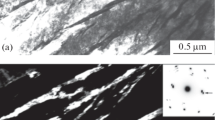The main structural differences between the 18th century Persian Bulat knife and the modern knife made of Kh (ShKh15) type bearing steel are considered. Qualitative and quantitative characteristics of carbide banding of high-carbon steels manufactured using Damascus steel technologies have been established. The nature of carbide banding is described in detail based on the shape of the planar projection lines of Bulat (Damascus) structure. Studies have confirmed that the matrix structure of tempered martensite and lamellar troostite is isometric and is not oriented in the direction of deformation. The carbide structure of steels manufactured using Damascus steel technologies is strongly oriented in the direction of deformation. It is calculated that the degree of orientation of linear elements in the two-dimensional metallographic specimen plane approaches unity. The regular layered banding (score 4) patterns are consistent with the structure of the Eastern genuine Damascus steels having an increased content of phosphorus admixture (0.1–0.3% P). The Damascus structure of alloyed tool steels is characterized by uneven reticular-fibrous carbide banding patterns (score 5).








Similar content being viewed by others
References
P. P. Anosov, “On Damascus steels,” Gornyi Zhurnal, Book 2, part 1, 157–317 (1841).
N. T. Belyaev, On Damascus Steels [in Russian], Typolitography of St. Petersburg prison, St. Petersburg (1906).
B. Zschokke, Du Damasse et des Lamés de Damast, Rev. de Metallurgie, 21, 635–669 (1924).
I. S. Gaev, “Bulat and modern iron-carbon alloys,” Metalloved. i Term. Obrab. Metallov, No. 9, 17–24 (1965).
Cl. Panseri, “Damascus steel in legend and in reality,” Gladius, No. 4, 5–66 (1965).
O. D. Sherby and J. Wadsworth, “Damascus steel.” Scientific American, 252 (2), 112–120 (1985).
J. Wadsworth and O. D. Sherby, “On the Bulat — Damascus steels revisited,” Progress in Materials Science, 25, 35–68 (1980).
F. N. Tavadze, B. G. Amaglobeli, and G. V. Inanishvili, “On the issue of studying Bulat steel,” Soobshcheniya AN Gruz. SSR, No. 3 (115), 589–592 (1984).
J. D. Verhoeven, A. H. Pendray, and E. D. Gibson, “Wootz-Damascus steel blades,” Materials Characterization, 37, 9–22 (1996).
J. D. Verhoeven, A. N. Pendray, and W. E. Dauksch, “The key role of impurities in ancient Damascus steel blades,” J. of Metallurgy, 50, 58–64 (1998).
J. D. Verhoeven, “Pattern formation in wootz Damascus steel swords and blades,” Indian Journal of History of Science, 42 (2), 559–574 (2007).
A. M. Feuerbach, “ Damascus steel and crucible steel in Central Asia,” American Society of Arms Collectors Bulletin, 82, 33–42 (2000).
A. A. Levin, D. C. Meyer, M. Reibold, W. Kochmann, N. Pätzke, and P. Paufler, “ Microstructure of a genuine Damascus sabre,” Cryst. Res. Technol., No. 9(40), 905–916 (2005).
M. R. Barnett, A. Sullivan, and R. Balasubramaniam, “ Electron backscattering diffraction analysis of an ancient wootz steel blade from Central India,” Materials Characterization, 60, 252–260 (2009).
I. N. Taganov and B. D. Kalinin, “ The effect of phosphorus impurity on Bulat technology,” Metalloobrabotka, No. 2 (50), 40–46 (2009).
V. M. Schastlivtsev, V. N. Urtsev, A. V. Shmakov, V. N. Degtyarev, A. Ya. Nakonechnyi, Ye. D. Mokshin, and I. L. Yakovleva, “Bulat structure,” Fizika Metallov i Metallovedeniya, No. 7(114), 650–657 (2013).
D. Ghasem, “An archaeometallurgical investigation of a steel sword from the Safavid dynasty,” The Minerals, Metals & Materials Society (JOM), No. 2(70), 243–247 (2018).
K. V. Tumanova, V. Yu. Bazhin, O. A. Dubovikov, A. V. Sundurov, and V. G. Povarov, “ A study of 19th century Georgian Bulat weapons from the collection of the mining museum of the mining university,” Chernye Metally, No. 2, 73–78 (2020).
D. A. Sukhanov, “Influence of phosphorus impurity on the structure and nature of the destruction of the genuine Damascus steel,” Intern. J. of Engineering Technologies and Management Research, No. 5 (4), 26–37 (2018).
D. A. Sukhanov and N. V. Plotnikova, “ Mechanical properties of 18th century Persian Bulat steel in comparison with modern tool steels,” Metallurg, No. 11, 50–60 (2019).
D. A. Sukhanov, “Topographic contour element features in patterned macrostructures of the 18th century Persian Bulat steel,” Metallurg, No. 2, 93–102 (2022).
D. A. Sukhanov, “Structural and fractographic features of 18th century Bulat knife blade fractures with impact bending,” Metallurg, No. 4, 99–107 (2022).
D. A. Sukhanov, “ Behavioral features of the 18th century Persian Bulat steel and modern Damascus steel under cyclic loading,” Metallurg, No. 6, 94–102 (2022).
D. A. Sukhanov, “Reconstruction of genuine Damascus structure of the 18th century eastern Pulvar saber blade,” Metallurg, No. 11, 115–124 (2022).
S. A. Saltykov, Stereometric Metallography [in Russian], Metallurgiya, Moscow (1976).
A. P. Vinogradov, “Soft Damascus steel and the origin of the Damascus pattern,” Izv. Dnepropetr. Gorn. Inst., 15, 115–213 (1928).
I. N. Golikov, Dendritic Liquation in Steel [in Russian], Metallurgizdat, Moscow (1958).
O. D. Sherby, T. Oyama, D. W. Kum, B. Walser, and J. Wadsworth, “Ultrahigh carbon steels,” J. of Metals, No. 6, 50–56 (1985).
E. M. Taleff, B. L. Bramfitt, C. K. Syn, D. R. Lesuer, J. Wadsworth, and O. D. Sherby, “ Processing, structure, and properties of a rolled, UHC steel plate exhibiting a Damask pattern,” Materials Characterization, 46, 11–18 (2001).
H. Sunada, J. Wadsworth, J. Lin, and O. D. Sherby, “ Mechanical properties and microstructure of heat-treated ultrahigh carbon steels,” Mater. Sci. and Eng., 38, 35–40 (1979).
Author information
Authors and Affiliations
Corresponding author
Additional information
Translated from Metallurg, Vol. 67, No. 1, pp. 103–111, January, 2023. Russian https://doi.org/10.52351/00260827_2023_01_103
Rights and permissions
Springer Nature or its licensor (e.g. a society or other partner) holds exclusive rights to this article under a publishing agreement with the author(s) or other rightsholder(s); author self-archiving of the accepted manuscript version of this article is solely governed by the terms of such publishing agreement and applicable law.
About this article
Cite this article
Sukhanov, D.A. Features of Morphology of Carbide Banding of High-Carbon Steels with Bulat Structure. Metallurgist 67, 111–122 (2023). https://doi.org/10.1007/s11015-023-01498-0
Received:
Revised:
Accepted:
Published:
Issue Date:
DOI: https://doi.org/10.1007/s11015-023-01498-0




